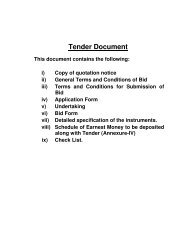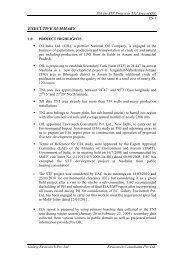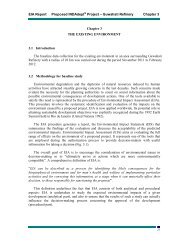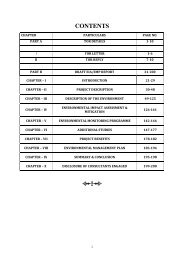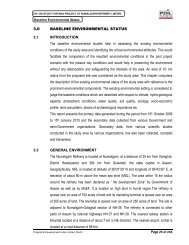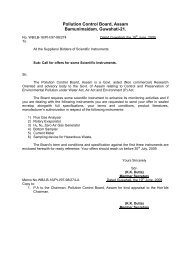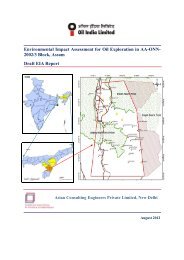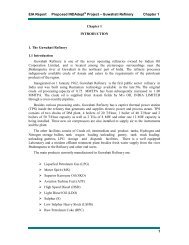EXECUTIVE SUMMARY - Pollution Control Board, Assam
EXECUTIVE SUMMARY - Pollution Control Board, Assam
EXECUTIVE SUMMARY - Pollution Control Board, Assam
Create successful ePaper yourself
Turn your PDF publications into a flip-book with our unique Google optimized e-Paper software.
1.0 GENERAL1.1 PREAMBLE<strong>EXECUTIVE</strong> <strong>SUMMARY</strong>Jumbo Roofings & Tiles (JRT)KATAMUR-VILLAGE, CHANGSARI-P.O.NORTH GUWAHATI CIRCLEKAMRUP RURAL DISTRICT, <strong>Assam</strong>Jumbo Roofings & Tiles (JRT) has proposed to setup an Asbestos CementCorrugated sheets, plain sheets, Roofing accessories and Non-Asbestossheets manufacturing Unit. The proposed capacity of the company is 50,000MT Per Annum (TPA). The Unit location is proposed at Katamur village,North Guwahati Revenue Circle, Kamrup Rural District of <strong>Assam</strong> state.The unit operates in the manufacture of Asbestos cement sheets. Theprocess involves fibre milling, opening, raw material slurry preparation &mixing, sheet making, moulding, curing and storing.In order to assess the likely impacts arising out of the proposed project,JRL had appointed PARYAVARAN LABS (INDIA) LTD., HYDERABAD toundertake the Rapid Environmental Impact Assessment (REIA) study forthe various environmental components which may be affected, to assess theimpact arising out of the proposed project and to prepare a detailedenvironmental management plan (EMP) to minimize those adverse impacts.It also examines the possible impact on the people, their home land ortheir livelihoods, or to other nearby developments.Baseline Data have been collected for the various environmentalcomponent such as air environment, water environment, landenvironment, noise environment and socio-economic environment duringPost monsoon and are presented in this report along with predictionand evaluation of impacts of the proposed project activities. After
The regular manpower required for administration, and productionpurposes will be around 50.1.0 PROCESS DESCRIPTION:The proposed capacity of the company is 50,000 MT Per Annum (TPA)Asbestos cement corrugated sheets & Tiles.RAW MATERIALSRaw Quantity/Day SourceMaterialCement 56.25 MT Nearby sourcesFly ash 40.63 MT Nearby Power stationFibre 11.25 MT Fully Imported from Canada, Brazil,RussiaPulp 0.88 MT LocalWater 28.67 MT Bore wellsMANUFACTURING PROCESS OF A.C. PRODUCTAsbestos Fiber of different grades are imported, mainly from Canada,Russia, Zimbabwe etc, and received in pressure packed condition inimpermeable bags in palletized form. The fibre pallets are transported tothe factory in closed containers through the trailer trucks. These palletizedfiber bags are unloaded in fiber go-downs with the help of fork lifts. Fiberbag pallets are conveyed to the fiber feeding section by means of fork lifts.The fiber bags shall be slit open in closed automatic bag opening device. Theempty bags shall be lifted by a hooking device attached within the bagopening device and carried to the attached bag shredder unit and the fiberafter passing through the lump breaker shall be collected in the attachedblender where some water shall be added to maintain the process in wetcondition.. When all the bags in one charge empties the fiber on to theblender, the fiber in wet form shall be taken to the Edge Runner Mill via ascrew conveyor and elevator which is also joined by the shredded bag pieces
from the shredder unit. Here at ERM some more water is further added tothe fibre for milling operation. The bag opening device & the edge runnermill shall be kept under negative pressure by tapping it on to a Bag FilterType Dust Collector with pulse jet which again is connected to a HydrostaticPrecipitator, connected to a blower (capacity _ 6000 m3/hr) driven bya 15 Hp motor. The delivery point of the blower is connected to the Air WetWasher and through to a 18 m tall stack. The Hydro-static Precipitatorworks on the principle of tidal wave generation. Particles collected in hydrostaticprecipitator shall be periodically recycled in wet form.From this point onwards the total process operations involving fibre arecarried out in wet condition with no possibility of dust generation duringmanufacturing process. The milled fiber is weighed in weigh hopper. Thepre-requisite quantity of fiber which is about 8% of the product is mixedwith required quantity of water in Wet Opener or fibre cone where it is recirculatedfor about 3 to 4 minutes. The above slurry along with otherfibers, if any, a small quantity (around less than 1%) of pulp and smallquantities of homogenized solid waste + process sludge in slurry form (fromsludge recycling tank/Wet Ball Mill) is taken to Beater tank. Cement isreceived and stored in go-down., from where it is conveyed to the Cement +Fly ash Mixing Tank via screw conveyor. Next, Fly ash is received and storedin closed go-down. Fly ash shall be pneumatically conveyed Pre-requisitequantity of Special binders - Fly ash (around 26 to 28 % of the product) ismixed with water, converted into slurry and sent to Storage tanks. Ameasured quantity of Fly ash slurry is taken to the Batch Hopper and thento the Cement + Fly ash Mixing Tank. The cement + FA slurry thusprepared in the Mixing tank is sent to Wet Rotary Sieve & thence to theBeater Tank, thus joining fiber slurry.The RM slurry thus prepared is transferred to Storage Tank where it isunder constant agitation. From here slurry is taken to the Dilution Tank(or
Distribution Tank) and diluted further using recycled process water. Slurryfrom the Dilution Tank is taken to the sheet forming machine consisting ofan assembly of 5 vats placed in series and with rotating sieve cylindersplaced one in each of 5 vats. The sieve cylinders are fitted at its periphery,with the wire mesh of specific size (mostly 40 mesh on top surface and 5mesh on bottom surface). An end-less felt made of synthetic woven fabricruns tangentially atop the sieve cylinders. The slurry through the sievecylinders gets filtered out. The differential hydrostatic pressure thus createdbetween the sieve cylinder and Vat causes an asbestos cement film to beformed and picked up by the sieve cylinder which in turn gets transferred tothe moving felt. The gradually thickening slurry due to filtration isconstantly diluted in the vats. The excess water in film is dehydrated byvacuum system. The wet film from the felt is then transferred on to therotating sheet forming drum.After the required thickness is achieved the wet sheet is cut by automaticcutter fixed on the sheet forming drum. The formed sheet is then trimmedwidthwise with long cutters to the required width. The length of the sheetvaries as per the market requirement from 1.5 M to 3 M. after cutting to therequired length the sheet is transferred on to the profiling machine(Corrugator) by vacuum sucking.The formed sheets are stacked in between the steel moulds ( templates)which will be air cured for about 12 hrs in a closed chamber. After the aircuring the sheets are separated out from the templates in destackermachine. The templates are cleaned and lubricated and sent back toprofiling machine. The sheets then are inspected on-line, stacked on steelpallets and water cured for a minimum of 12 days before being finallyinspected and then dispatched.
1.1 AIR POLLUTION SOURCES & CONTROL MEASURESFiber Bag Opening and MillingThe fiber bags shall be slit open in closed automatic bag opening device. Theempty bags shall be lifted by a hooking device attached within the bagopening device and carried to the attached bag shredder unit and the fiberafter passing through the lump breaker shall be collected in the attachedblender where some water shall be added to maintain the process in wetcondition.. When all the bags in one charge empties the fiber on to theblender, the fiber in wet form shall be taken to the Edge Runner Mill via ascrew conveyor and elevator which is also joined by the shredded bag piecesfrom the shredder unit. Here at ERM some more water is further added tothe fibre for milling operation. The bag opening device & the edge runnermill shall be kept under negative pressure by tapping it on to a Bag FilterType Dust Collector with pulse jet which again is connected to a two stageventure scrubber, connected to a blower (capacity _ 6000 m3/hr) driven bya 15 Hp motor. The delivery point of the blower is connected to a 18 m tallstack.Cement and Fly ash Feeding‣ The cement feeding point shall be tapped on to bag filter type dustcollector with pulse jet and with a blower (capacity - 2500 m3/hr ) drivenby a 5HP MOTOR. The let out shall be through a stack of 18 m height.‣ The Fly ash feeding point shall be tapped on to bag filter type dustcollector with pulse jet and with a blower (capacity - 2500 m3/hr ) drivenby a 5HP MOTOR. The let out shall be through a stack of 18 m height.Standby Power Supply System - DG sets - Pollutant:Particulate matter, SO 2 and NOx 15 Meters stack height.Suspended
2.0 NOISEJRT is procuring Compressors and Generators with Noise protectionsystems as per CPCB norms.3.0 WATER ENVIRONMENTThere will be no waste water generated due to the process. The sanitarywaste is diverted into a septic tank followed by soak pit.3.1 RAIN WATER HARVESTINGBased on available data on roof area – 5 no. rain harvesting pits have beenenvisaged, to ensure charging of ground water. Pits will be made with graveland sand filled in as filtering media. TANK SIZES: 5.0MX5.0MX3.0M(MWD)in 5 nos.4.0 . SOLID WASTE MANAGEMNTSolid Waste Generation1. Empty Fibre Bags – From Bag Opening Device (BOD) = 0.0261 MT2. Fibre Dust – From Dust Collector at ER Mill & BOD = 0.0058 MT3. Process Sludge – From Week-End Tank = 0.0484 MT4. Hard Broken Pieces – From Damages/Rejects = 1.4013 MT5. Cement Dust – From Dust Collector at Cem Feeding = 0.0241 MT6. Fly Ash Dust – From Dust Collector at FA Feeding = 0.0197 MTDisposal (Fully Recycled)1. Shredded in the Shredder unit attached to the Bag Opening Deviceand sent along with the opened fibre through the screw conveyor.2. Periodically recycled after the container containing water andplaced beneath the rotary valve of the Dust Collector isadequately filled in.
3&4. Continuously recycled though the Wet Ball Mill in slurry form.5&6. Periodically recycled after the containers placed beneath the rotaryvalve of the respective Dust Collectors are adequately filled in.5. 0 GREEN BELT DEVELOPMENTTo maintain the ecological balance JRL authorities have proposed to developgreen belt in and around the plant. Green belt recommendations madearound the project site evolved for noise pollution control, balancing ecoenvironment,soil erosion /protection, economic sustenance and aesthetics.The scenario of planting arrangement made and size based on the optimumuse of available land.Total land allocated for green belt development plan is - 15000 Sq.m.6.0 POST PROJECT MONITORINGPersonal/Static SamplingLow Volume Sampler. Fibre countStack Emission(for fibre, cement & fly ash)Ambient Air Monitoring(at 3 equi-angled stations with RMsec as centre point, within the site,Monthly(for each location)Monthly(for each stack)Monthly(for each station)
7.0 EXPENDITURE ON ENVIRONMENTAL MANAGEMENT PLANSL ITEM RsinLakhsCAPITAL EXPENDITURE:1 Air <strong>Pollution</strong> control equipment like IDfans, Bag Filters, s connected tocement, Flyash & Fibre handlingsystems (main equipment) includingstacks.3 Sewage Treatment for Doestic wastewater.4 Emission Monitoring equipment atsources and ambient air quality in thevicinity) and laboratory.30.005.0010.005 Green belt development. 10.006 Establishment of Environment cell andEnvironmental Monitoring.10.007 Total Capital Expenditure 65.00RECURRINGEXPENDITURE:8 Recurring expenditure on6.50environmental management cell and onpollution control systems is about 10%of the Env. Management & Equipmentcapital.
BUDGET FOR WELFARE MEASURESSL ITEM INVESTMENT,RS IN Lakhs1 School & Education 2.002 Medical Services 2.003 Roads Development 2.004 Community Development 2.005 Supporting Self-helpgroups2.00Total 10.00<strong>SUMMARY</strong> AND CONCLUSIONI. Production and Process management1. The technology chosen and machinery selected are energyefficient and environment friendly.2. Plant designed to meet all the standard norms of State andCentral pollution <strong>Control</strong> <strong>Board</strong>s and MOE&F .3. Noise levels designed at less than 90 dBAs as per OHS standardof 90 dBs of 8 hours exposure at work EnvironmentII.<strong>Pollution</strong> control equipment1. Pulse Jet bag filters For all Emission Sources.2. Stack monitoring of SPM, SOX and NOX3. Annual maintenance budget provided @ Rs.6.50 Lakhs.
III.Material handling and storage1. All spillages and deposits on structures will be cleaned uppromptly using vacuum cleaners or vacuum system.2. Automatic devices and control systems will be used.3. Traffic areas, including roads and areas with regular vehiclemovement, will be paved with a suitable road-way covering andbe kept clean constantly4. Boundary of the plant s surrounded with thick plantation.5. Thick plantation along the unpaved haul road also be provided.IV.Corporate environment management1. Corporate environment policy.2. Utmost importance is given to occupational health and safety.3. Socio-economic development4. Encouraging and creating opportunities for self employment5. Infrastructure strengthening and development6. Environmental Policy to ensure overall eco-friendly plant7. Environmental management cell for regular reviews andensuing correct implementation of policy.JRT strongly believes in the concept of eco friendly industrialization.Apart from eco -friendly operations, various socio economic developmentactivities will be undertaken to bring about overall socio economicimprovements in the areas. Hence the project may be accordedenvironmental clearance.


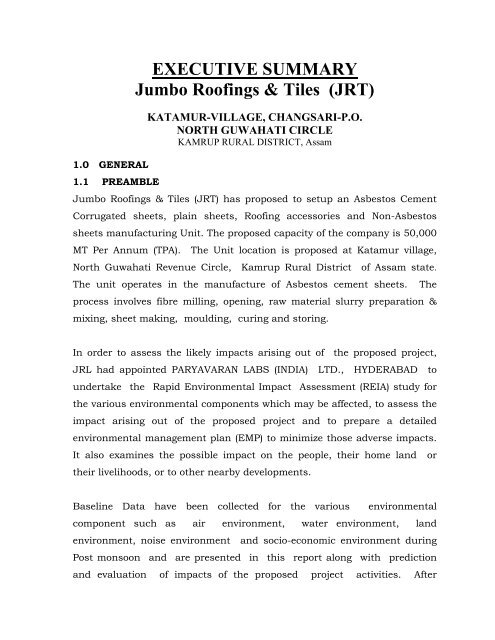

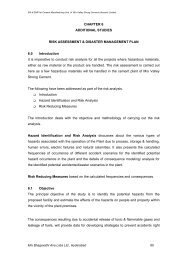
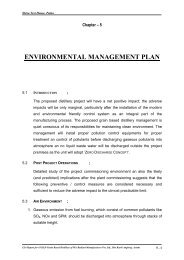
![a]ÝĖ^į %XĮ[ýįV - Pollution Control Board, Assam](https://img.yumpu.com/50573985/1/190x245/ayei-xiyiv-pollution-control-board-assam.jpg?quality=85)
